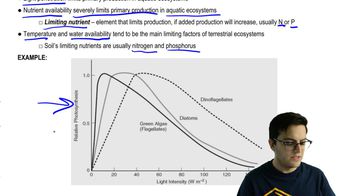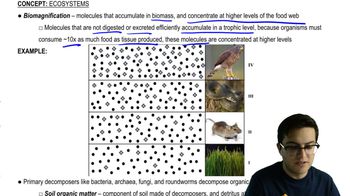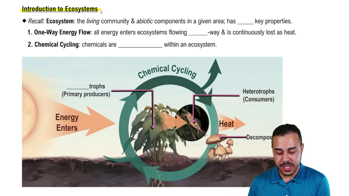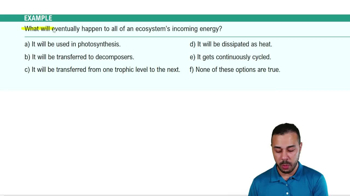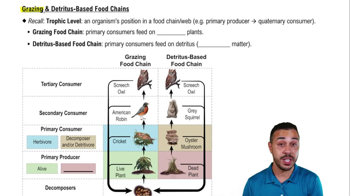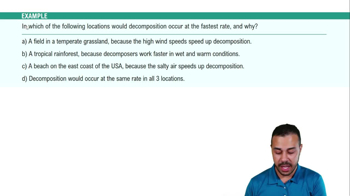Table of contents
- 1. Introduction to Biology2h 42m
- 2. Chemistry3h 40m
- 3. Water1h 26m
- 4. Biomolecules2h 23m
- 5. Cell Components2h 26m
- 6. The Membrane2h 31m
- 7. Energy and Metabolism2h 0m
- 8. Respiration2h 40m
- 9. Photosynthesis2h 49m
- 10. Cell Signaling59m
- 11. Cell Division2h 47m
- 12. Meiosis2h 0m
- 13. Mendelian Genetics4h 44m
- Introduction to Mendel's Experiments7m
- Genotype vs. Phenotype17m
- Punnett Squares13m
- Mendel's Experiments26m
- Mendel's Laws18m
- Monohybrid Crosses19m
- Test Crosses14m
- Dihybrid Crosses20m
- Punnett Square Probability26m
- Incomplete Dominance vs. Codominance20m
- Epistasis7m
- Non-Mendelian Genetics12m
- Pedigrees6m
- Autosomal Inheritance21m
- Sex-Linked Inheritance43m
- X-Inactivation9m
- 14. DNA Synthesis2h 27m
- 15. Gene Expression3h 20m
- 16. Regulation of Expression3h 31m
- Introduction to Regulation of Gene Expression13m
- Prokaryotic Gene Regulation via Operons27m
- The Lac Operon21m
- Glucose's Impact on Lac Operon25m
- The Trp Operon20m
- Review of the Lac Operon & Trp Operon11m
- Introduction to Eukaryotic Gene Regulation9m
- Eukaryotic Chromatin Modifications16m
- Eukaryotic Transcriptional Control22m
- Eukaryotic Post-Transcriptional Regulation28m
- Eukaryotic Post-Translational Regulation13m
- 17. Viruses37m
- 18. Biotechnology2h 58m
- 19. Genomics17m
- 20. Development1h 5m
- 21. Evolution3h 1m
- 22. Evolution of Populations3h 52m
- 23. Speciation1h 37m
- 24. History of Life on Earth2h 6m
- 25. Phylogeny2h 31m
- 26. Prokaryotes4h 59m
- 27. Protists1h 12m
- 28. Plants1h 22m
- 29. Fungi36m
- 30. Overview of Animals34m
- 31. Invertebrates1h 2m
- 32. Vertebrates50m
- 33. Plant Anatomy1h 3m
- 34. Vascular Plant Transport1h 2m
- 35. Soil37m
- 36. Plant Reproduction47m
- 37. Plant Sensation and Response1h 9m
- 38. Animal Form and Function1h 19m
- 39. Digestive System1h 10m
- 40. Circulatory System1h 57m
- 41. Immune System1h 12m
- 42. Osmoregulation and Excretion50m
- 43. Endocrine System1h 4m
- 44. Animal Reproduction1h 2m
- 45. Nervous System1h 55m
- 46. Sensory Systems46m
- 47. Muscle Systems23m
- 48. Ecology3h 11m
- Introduction to Ecology20m
- Biogeography14m
- Earth's Climate Patterns50m
- Introduction to Terrestrial Biomes10m
- Terrestrial Biomes: Near Equator13m
- Terrestrial Biomes: Temperate Regions10m
- Terrestrial Biomes: Northern Regions15m
- Introduction to Aquatic Biomes27m
- Freshwater Aquatic Biomes14m
- Marine Aquatic Biomes13m
- 49. Animal Behavior28m
- 50. Population Ecology3h 41m
- Introduction to Population Ecology28m
- Population Sampling Methods23m
- Life History12m
- Population Demography17m
- Factors Limiting Population Growth14m
- Introduction to Population Growth Models22m
- Linear Population Growth6m
- Exponential Population Growth29m
- Logistic Population Growth32m
- r/K Selection10m
- The Human Population22m
- 51. Community Ecology2h 46m
- Introduction to Community Ecology2m
- Introduction to Community Interactions9m
- Community Interactions: Competition (-/-)38m
- Community Interactions: Exploitation (+/-)23m
- Community Interactions: Mutualism (+/+) & Commensalism (+/0)9m
- Community Structure35m
- Community Dynamics26m
- Geographic Impact on Communities21m
- 52. Ecosystems2h 36m
- 53. Conservation Biology24m
52. Ecosystems
Introduction to Ecosystems
Problem 8`
Textbook Question
If you applied a fungicide to a cornfield, what would you expect to happen to the rate of decomposition and net ecosystem production (NEP)?
a. Both decomposition rate and NEP would decrease.
b. Neither would change.
c. Decomposition rate would increase and NEP would decrease.
d. Decomposition rate would decrease and NEP would increase.
 Verified step by step guidance
Verified step by step guidance1
Understand the role of fungi in an ecosystem: Fungi are decomposers, meaning they break down organic matter, recycling nutrients back into the ecosystem. This process is crucial for maintaining the balance of nutrients in the soil.
Consider the effect of a fungicide: A fungicide is a chemical that kills fungi. Applying it to a cornfield would likely reduce the population of fungi, thereby affecting their ability to decompose organic matter.
Analyze the impact on decomposition rate: With fewer fungi present due to the fungicide, the rate of decomposition would decrease because there are fewer organisms to break down organic material.
Evaluate the effect on net ecosystem production (NEP): NEP is the balance between the total amount of carbon fixed by photosynthesis and the total amount of carbon released by respiration and decomposition. If decomposition decreases, less carbon is released back into the atmosphere, potentially increasing NEP.
Conclude the expected changes: Based on the analysis, applying a fungicide would likely lead to a decrease in decomposition rate and an increase in NEP, aligning with option d.
 Verified video answer for a similar problem:
Verified video answer for a similar problem:This video solution was recommended by our tutors as helpful for the problem above
Video duration:
1mPlay a video:
Was this helpful?
Key Concepts
Here are the essential concepts you must grasp in order to answer the question correctly.
Decomposition Rate
Decomposition rate refers to the speed at which organic matter is broken down by decomposers, such as fungi and bacteria, into simpler substances. This process is crucial for nutrient cycling in ecosystems, as it releases nutrients back into the soil, making them available for plant uptake. Applying a fungicide can reduce the population of fungi, potentially slowing down the decomposition rate.
Recommended video:
Guided course

Metabolic Rate
Net Ecosystem Production (NEP)
Net Ecosystem Production (NEP) is the balance between the total amount of carbon dioxide absorbed by photosynthesis and the carbon dioxide released through respiration and decomposition in an ecosystem. NEP indicates the net gain or loss of carbon in an ecosystem, reflecting its productivity. A decrease in decomposition due to fungicide application might lead to an increase in NEP, as less carbon is released back into the atmosphere.
Recommended video:
Guided course

Making Sense of Ecosystem Production & Efficiency
Impact of Fungicides on Ecosystems
Fungicides are chemicals used to kill or inhibit the growth of fungi, which play a vital role in decomposition and nutrient cycling. Their application can disrupt the balance of ecosystems by reducing fungal activity, affecting decomposition rates and potentially altering ecosystem productivity. Understanding these impacts is essential for predicting changes in ecosystem functions, such as NEP, following fungicide use.
Recommended video:
Guided course

Geographic Impact on Communities

 4:07m
4:07mWatch next
Master Introduction to Ecosystems with a bite sized video explanation from Jason
Start learningRelated Videos
Related Practice





